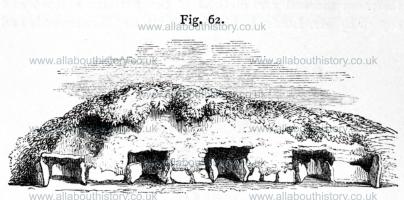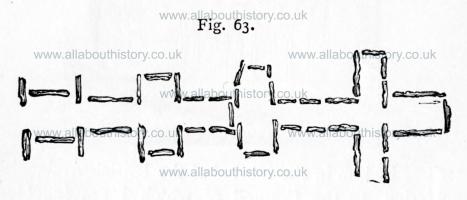Text this colour links to Pages. Text this colour links to Family Trees. Place the mouse over images to see a larger image. Click on paintings to see the painter's Biography Page. Mouse over links for a preview. Move the mouse off the painting or link to close the popup.
Stoney Littleton Long Barrow is in Stoney Littleton, Somerset, South England Neolithic Burials.
3500BC. Stoney Littleton Long Barrow [Map] is a Long Barrow constructed around 3500BC ±500 years around 7.5km south of Bath on high unlevel ground above a bend in the River Wellow. It is a Severn Cotswolds type tomb. The stone structure is about 30 metres in length, 3m high, and contains a 12.8 metres long gallery with a roof of overlapping stones with three pairs of side chambers and an end chamber. The tomb was excavated by Richard Colt Hoare 2nd Baronet in 1816-1817.

Archaeologia Volume 19 Section IV. 1816. An Account of a Stone Barrow [Map], in the Parish of Wellow, at Stoney Littleton [Map] in the County of Somerset, which was opened and investigated in the Month of May 1816. Communicated by Sir Richard Colt Hoare (age 57), Bart. F.S.A. Read 22d May, 1817.
Proceedings of the Somerset Archaeological and Natural History Society Volume 8 Pages 35-62. Remarks on ancient chambered tumuli as illustrative still existing at Stoney Littleton [Map], near Wellow, in the county of Somerset. By The Rev. H. M. Scarth (age 44), M.A.
Llewellynn Jewitt 1870. In England, besides those already named, and others, "Wayland," or "Wieland Smith's Cave [Map]," at Ashbury, in Berkshire; one at Stoney Littleton [Map], near Wellow, in Somersetshire ; the "Five Wells," at Taddington, in Derbyshire; and one or two others in the same county, as well as in other places, are the most important. The annexed woodcut, fig. 62, exhibits a section of the chambered tumulus at Stoney Littleton, and fig. 63 is a ground plan of the same. "The entrance was on the north-west side, where a stone upwards of seven feet long and three and a half feet wide, supported by two others, left a square aperture of about four feet high, which had been closed by another large stone. This entrance led to a long passage or avenue, extending in the direction from north-west to south-east forty-seven feet six inches, and varying in breadth. There were three transepts, or recesses, on each side. The side walls were formed of thin laminasof stone piled closely together without cement, and a rude kind of arched roof made of stones so placed as to overlap each other. When the large stones in the side walls did not join, the interstices were filled up with layers of small ones.1 Interments had evidently been made in each of these chambers, some by cremation, and others by inhumation, but the bones were scattered about, the result of previous rifling of its contents. One urn was found.
Note 1. T. Wright.



Proceedings of the Somerset Archaeological and Natural History Society Volume 87 1941 Pages 56-71. 1. Stoney Littleton Tumulus [Map], Wellow. (Plan, Plate XIII).